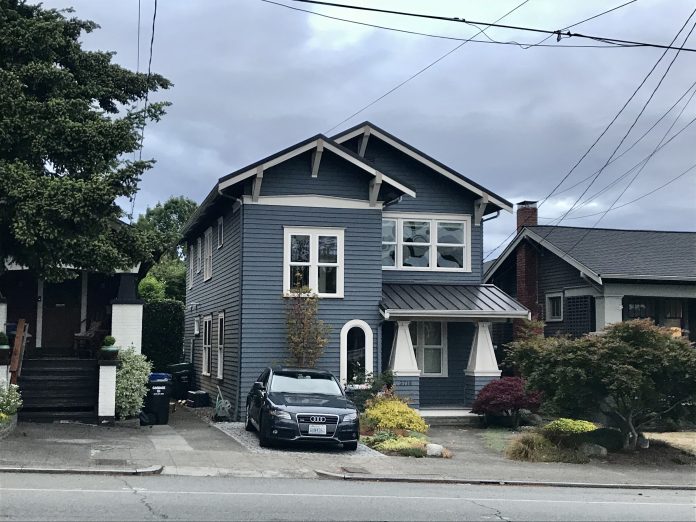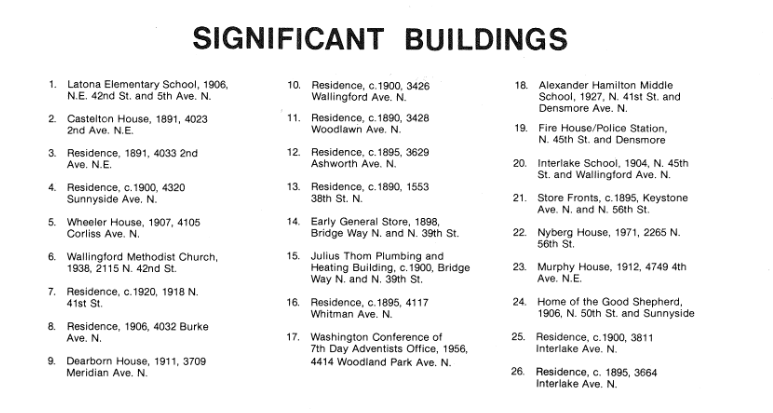If Seattle’s Mandatory Housing Affordability (MHA) program set a citywide precedent, then a push by wealthy Wallingford homeowners to turn single-family zoned areas into federally-designated historic districts could be a new variation on restrictive covenants. The city’s MHA overview document contains a note on just this issue, stating MHA would, “Make no zoning changes in federally designated historic districts and critical shorelines.” Councilmembers also supported excluding newly-minted national historic districts in Roosevelt and Mount Baker from MHA rezones in 2019 after an appeal remand.
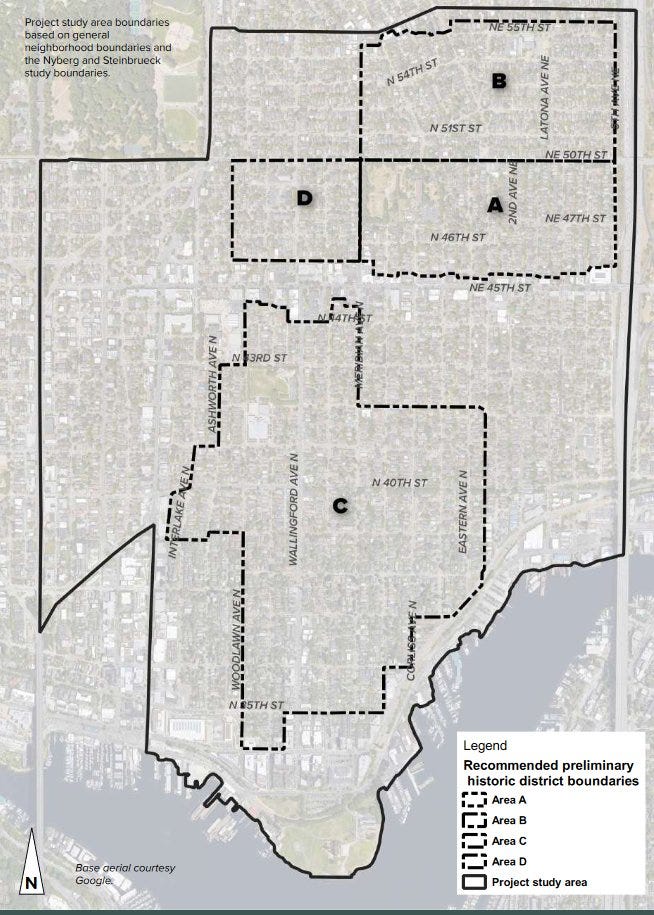
Historic Wallingford’s proposed “historic district” boundaries would encapsulate nearly 50% of the Wallingford Urban Village planning area, including almost all of the Lowrise multifamily and single-family zoned sections in and around the urban village itself.

Here’s what the proposed boundary look like over the city’s zoning map—a big yikes. I’ve added a blue fill for the proposed historic districts on the zoning map. The lightest blue? It’s all single-family zoning, a designation that should never have existed in the first place (and didn’t in Seattle prior to 1923). The darker blue is the proposed historic district overlaid on Lowrise multifamily zoning (brown on the zoning map).
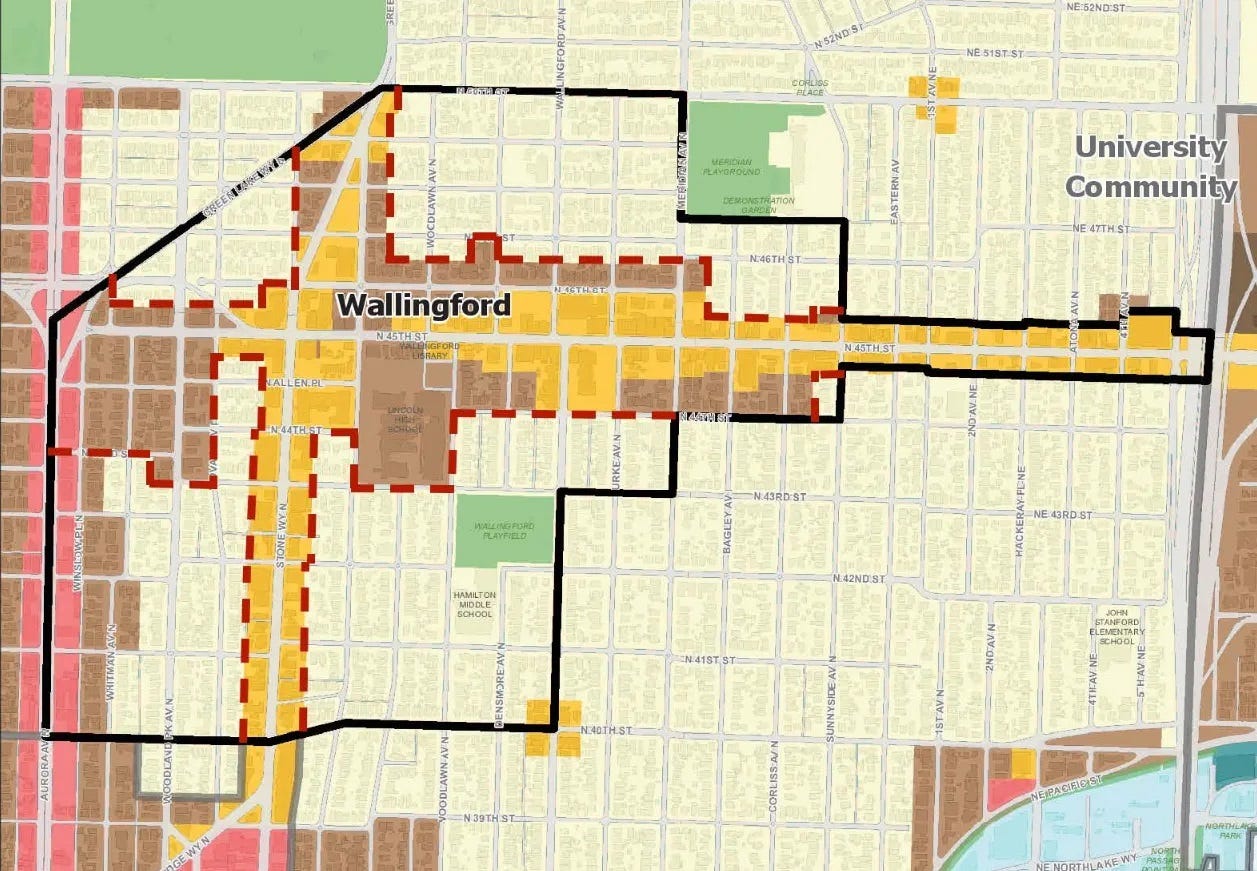
For those of you have been following the exclusionary antics of Wallingford for a few years, this shouldn’t seem a surprise. The historic district boundary largely matches an attempt by the Wallingford Community Council (WCC), that beacon of diversity and inclusion limited almost exclusively to homeowners, to contract the Wallingford Urban Village boundary by 50 blocks (the dashed red line was their proposed contraction) to exclude all of the single-family zoning—a move that would have focused all development on N 45th St and Stone Way N.
Many of the people who support this absurd historic district opposed many of the recent land use actions in the city. The WCC vocally opposed liberalizing backyard cottage and accessory dwelling unit (ADU) land use regulations. The WCC was opposed to any of the changes in the ADU ordinance (including eliminating the parking requirement), sending out a sample letter stating, “I encourage you to keep the current accessory unit rules allowing ADUs and DADUs to remain in place, as-is, with no rule changes.” So equitable. So inclusive. So sustainable.
Speaking of parking, WCC largely opposed relaxing mandatory parking requirements near transit. There’s also a lot of overlap opposing the incredibly nominal rezones for affordable housing that the city council passed just a few years ago, using heinous terminology about renters and other folks who supported allowing more affordable housing in more of the city. The WCC also participated in the homeowner’s association that attempted to get the affordable housing killed entirely—delaying it for years, and preventing seven hundred affordable homes from being built according Crosscut.
Now what about the demographics of the region? This is why I believe that new historic districts are being used as a new form of restrictive covenants.

Let’s look at the northern section of the proposed district (Tangletown). The 2017 American Community Survey says that this census tract (KC 46) is 91% White, the one to the east (KC 45) of it is 85% White, and the one to the south (KC 51), almost fully inside the proposed boundary, is 87% White—the Seattle average is 69% White. The percentage of renters? Despite being near the core city, North Seattle Community College, and the University of Washington, some of these tracts are only 38% renters, also significantly below the Seattle average of 53% renter—yes, Seattle is a majority renter city, and has been for a while now.
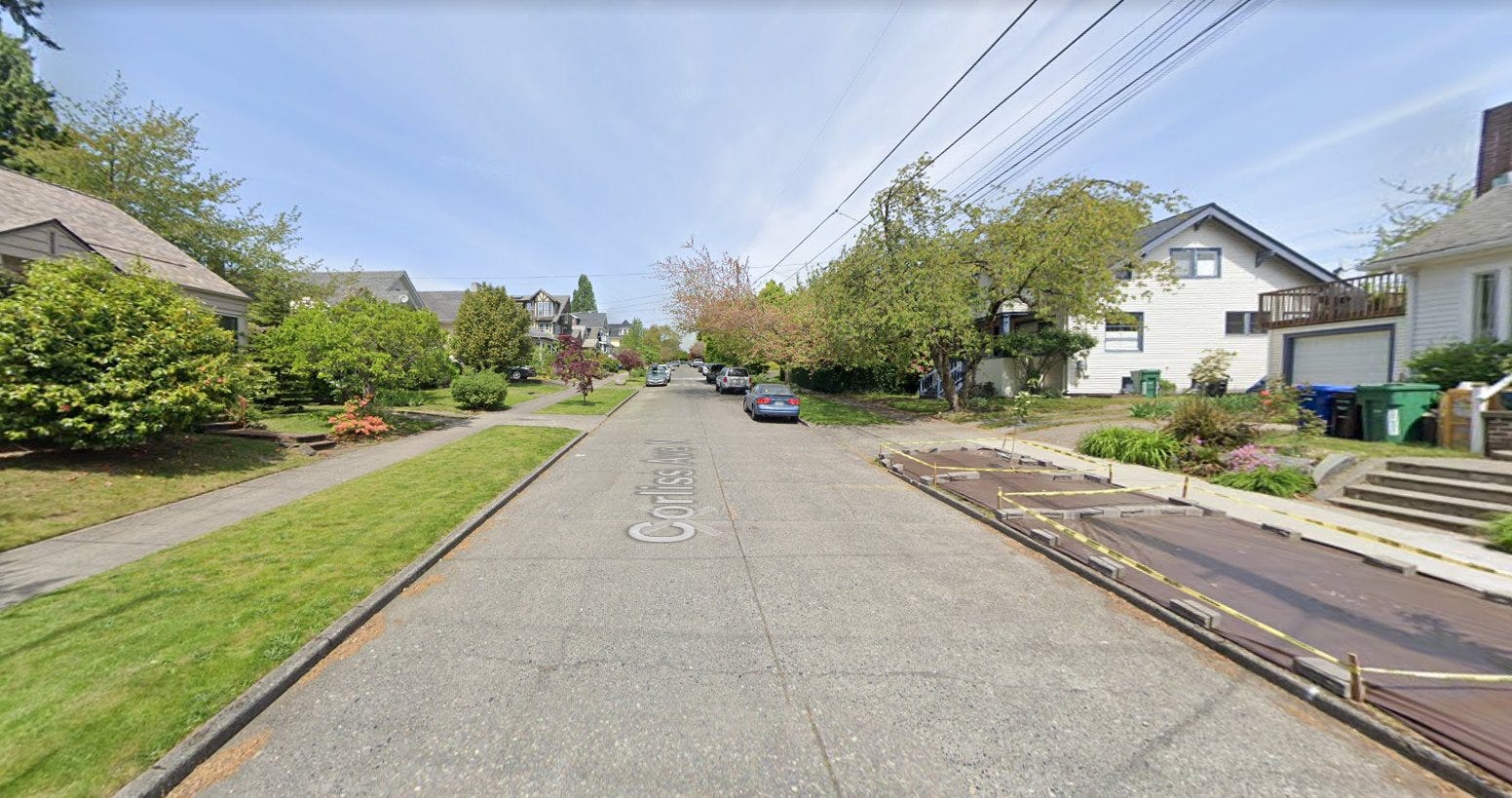
Now when I look at these streets, which will be a very quick walk, bus, or bike ride to the University District or Roosevelt light rail stations, it is pretty obvious to me why we have a housing crisis, and why we keep failing to meet our climate goals.
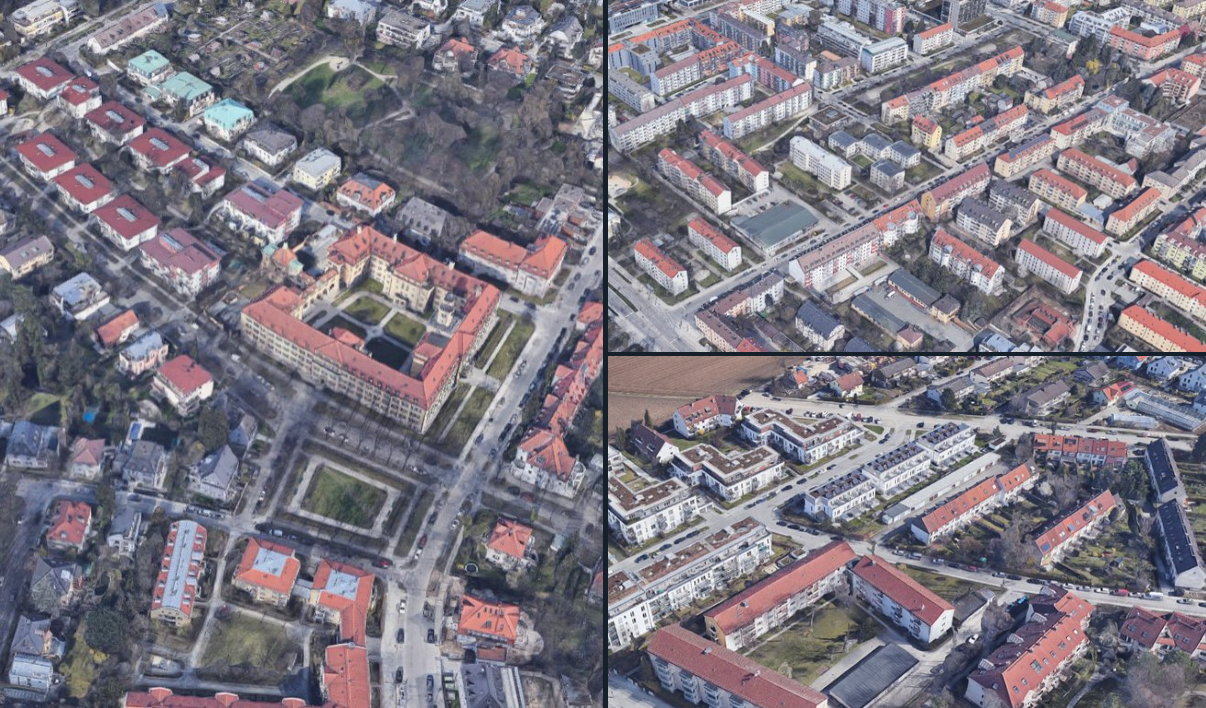
To contrast, this is what neighborhoods in Munich look like the same distance from the city center—rowhouses, small multifamily buildings, large multifamily buildings, and post-war blocks. It should also be noted that social housing would effectively be illegal to build for the entirety of the proposed Wallingford historic district. Social housing is legal on every buildable parcel in Munich. Same for Vienna, Freiburg, Amsterdam, Zurich, Stockholm, and Paris. We should probably follow suit.
From a historic standpoint, this is just another attempt by wealthy homeowners —who ironically are a minority of the Wallingford Urban Village—to keep those less well off out of their neighborhood. In the 1990s, Wallingford homeowners abused the neighborhood planning component of the Urban Village strategy—effectively only allowing the loud, dangerous, polluted arterials already zoned for multifamily housing to be the limits of where new multifamily housing would be allowed. According to KUOW, in the 1980s, Wallingford homeowners got the Lowrise sections of the neighborhood that were increasingly being inhabited by University of Washington workers and students downzoned, to prevent these nominal changes. And Wallingford’s special brand of exclusion also got noted in the UW’s Racial Restrictive Covenants History report: “The maps suggest little difference in the demography of Wallingford, where no covenants have been located, from the demography of Ballard, Loyal Heights, and Greenlake, where they were common. This reemphasizes the point that social enforcement of segregation was every bit as important as legally enforcing deed restrictions.”
It should also be noted that these sections of Wallingford have already been studied for historic significance. In 1976, Seattle Architects Victor Steinbrueck and Folke Nyberg completed a study of the proposed historic district, and found just 15 homes out of the thousand or so residing in the area at the time, labeling them as, “Significant to the city—warrant further evaluation for designation as historic landmark.” It didn’t even necessarily state these were worth landmarking—just studying that they may be.
A few years ago for Sightline, I wrote about how Wallingford’s well off, and well-connected homeowners have used exclusionary processes to greatly contribute to our housing affordability crisis. And yes, I do mean well off. According to Zillow, the average single-family home in Wallingford is 40% higher in value than Seattle’s average, and those who bought a home for $10,000 in the 1960s, as stated in the KUOW story, would have seen their home values grow at 13 times the rate of inflation. As for what you can do, there’s currently a petition opposing this project which you can sign. More importantly, you should contact your councilmembers and ensure that historic districts can not be yet another tool wielded by those living in exclusive enclaves to prevent rezoning for a more equitable, inclusive, and sustainable city.
Mike is the founder of Larch Lab, an architecture and urbanism think and do tank focusing on prefabricated, decarbonized, climate-adaptive, low-energy urban buildings; sustainable mobility; livable ecodistricts. He is also a dad, writer, and researcher with a passion for passivhaus buildings, baugruppen, social housing, livable cities, and car-free streets. After living in Freiburg, Mike spent 15 years raising his family - nearly car-free, in Fremont. After a brief sojourn to study mass timber buildings in Bayern, he has returned to jumpstart a baugruppe movement and help build a more sustainable, equitable, and livable Seattle. Ohne autos.

